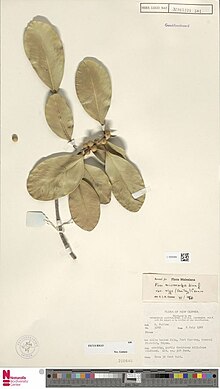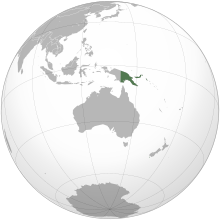Ficus rigo: Difference between revisions
m Dating maintenance tags: {{Cn}} |
Ariana Egg (talk | contribs) m added links |
||
| Line 14: | Line 14: | ||
== Description == |
== Description == |
||
This evergreen tree can grow up to 12 meters in height. [[Fig wasp]]s aid in pollination, with each type of fig tree reliant on a distinct species of wasp for fertilization.<ref>{{BioRef|powo |title=''Ficus rigo'' F.M.Bailey |id=853595-1 |access-date=2024-03-06}}</ref> The fig trees produce three types of flowers: male, long-styled female, and short-styled female (gall flower). These flowers are contained within the fig structure, commonly referred to as the fruit. The intricate process of fig pollination involves female fig wasps laying eggs on short-styled female flowers while pollinating the long-styled female flowers. Male fig wasps, which are wingless, emerge first to inseminate the emerging females and create exit tunnels out of the fig for the winged females. Once females emerge, they collect [[pollen]] from the male flowers and seek out figs with receptive female flowers. This relationship between fig trees and fig wasps necessitates asynchronous flowering (as opposed to [[synchronous flowering]]) within a population to support the pollinator species. If there is no temporal overlap in flowering, the pollinator wasps may go locally [[Extinction|extinct]].<ref>{{GBIF |title=''Ficus rigo'' F.M.Bailey |id=5571352 |access-date=2024-03-06}}</ref>{{cn|reason=Need source on wasp pollination|date=March 2024}} |
This evergreen tree can grow up to 12 meters in height. [[Fig wasp]]s aid in pollination, with each type of [[Fig Tree|fig tree]] reliant on a distinct species of wasp for fertilization.<ref>{{BioRef|powo |title=''Ficus rigo'' F.M.Bailey |id=853595-1 |access-date=2024-03-06}}</ref> The fig trees produce three types of flowers: male, long-styled female, and short-styled female ([[gall flower]]). These flowers are contained within the fig structure, commonly referred to as the fruit. The intricate process of fig pollination involves female fig wasps laying eggs on short-styled female flowers while pollinating the long-styled female flowers. Male fig wasps, which are wingless, emerge first to inseminate the emerging females and create exit tunnels out of the fig for the winged females. Once females emerge, they collect [[pollen]] from the male flowers and seek out figs with receptive female flowers. This relationship between fig trees and fig wasps necessitates [[asynchronous flowering]] (as opposed to [[synchronous flowering]]) within a population to support the pollinator species. If there is no temporal overlap in flowering, the pollinator wasps may go locally [[Extinction|extinct]].<ref>{{GBIF |title=''Ficus rigo'' F.M.Bailey |id=5571352 |access-date=2024-03-06}}</ref>{{cn|reason=Need source on wasp pollination|date=March 2024}} |
||
''Ficus rigo'' produces latex that can be used to make rubber similar to ''[[Hevea brasiliensis]]''. Propagation of ''Ficus rigo'' can be done through seeds or [[Cutting (plant)|cuttings]], with cuttings being particularly successful in rooting. In its native range, this species primarily grows in the wet tropical biome.<ref name=":0" /> |
''Ficus rigo'' produces latex that can be used to make rubber similar to ''[[Hevea brasiliensis]]''. Propagation of ''Ficus rigo'' can be done through seeds or [[Cutting (plant)|cuttings]], with cuttings being particularly successful in rooting. In its native range, this species primarily grows in the wet tropical [[biome]].<ref name=":0" /> |
||
== Habitat == |
== Habitat == |
||
Revision as of 15:59, 8 March 2024
This article needs more links to other articles to help integrate it into the encyclopedia. (March 2024) |
| Ficus rigo | |
|---|---|

| |
| Scientific classification | |
| Kingdom: | Plantae |
| Clade: | Tracheophytes |
| Clade: | Angiosperms |
| Clade: | Eudicots |
| Clade: | Rosids |
| Order: | Rosales |
| Family: | Moraceae |
| Genus: | Ficus |
| Species: | F. rigo
|
| Binomial name | |
| Ficus rigo | |

| |
Ficus rigo, an endangered evergreen tree reaching heights of up to 15 meters, features an unbuttressed bole and typically lacks extensive aerial roots, though in older specimens, these roots may develop into subsidiary trunks. Interestingly, this tree can initially begin its life as an epiphyte in the branches of another tree. One notable characteristic of Ficus rigo is its production of latex, which has historically been utilized in rubber production. In the past, it was cultivated specifically for this purpose.[2]
Description
This evergreen tree can grow up to 12 meters in height. Fig wasps aid in pollination, with each type of fig tree reliant on a distinct species of wasp for fertilization.[3] The fig trees produce three types of flowers: male, long-styled female, and short-styled female (gall flower). These flowers are contained within the fig structure, commonly referred to as the fruit. The intricate process of fig pollination involves female fig wasps laying eggs on short-styled female flowers while pollinating the long-styled female flowers. Male fig wasps, which are wingless, emerge first to inseminate the emerging females and create exit tunnels out of the fig for the winged females. Once females emerge, they collect pollen from the male flowers and seek out figs with receptive female flowers. This relationship between fig trees and fig wasps necessitates asynchronous flowering (as opposed to synchronous flowering) within a population to support the pollinator species. If there is no temporal overlap in flowering, the pollinator wasps may go locally extinct.[4][citation needed]
Ficus rigo produces latex that can be used to make rubber similar to Hevea brasiliensis. Propagation of Ficus rigo can be done through seeds or cuttings, with cuttings being particularly successful in rooting. In its native range, this species primarily grows in the wet tropical biome.[2]
Habitat
Ficus rigo is primarily found in Australasia, specifically in southeast New Guinea. Its habitat is typically near or on the coast.
References
- ^ Kipiro, W.; Jimbo, T. (2020). "Ficus rigo". IUCN Red List of Threatened Species. 2020: e.T142811636A143763599. doi:10.2305/IUCN.UK.2020-3.RLTS.T142811636A143763599.en.
- ^ a b "Ficus rigo - Useful Tropical Plants". tropical.theferns.info. Retrieved 2024-03-06.
- ^ "Ficus rigo F.M.Bailey". Plants of the World Online. Royal Botanic Gardens, Kew. Retrieved 2024-03-06.
- ^ "Ficus rigo F.M.Bailey". Global Biodiversity Information Facility. Retrieved 2024-03-06.

